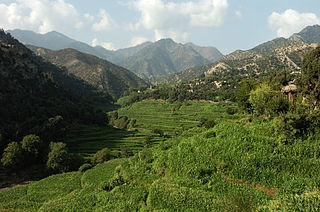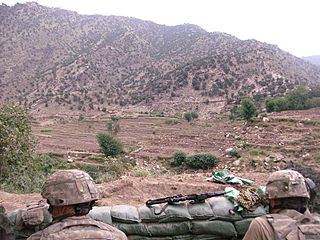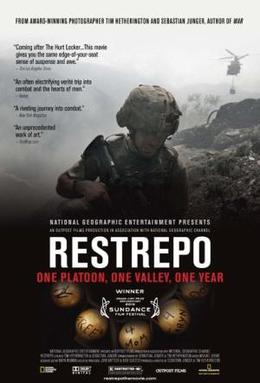
Sebastian Junger is an American journalist, author and filmmaker who has reported in-the-field on dirty, dangerous and demanding occupations and the experience of infantry combat. He is the author of The Perfect Storm: A True Story of Men Against the Sea (1997) which was adapted into a major motion picture and led to a resurgence in adventure creative nonfiction writing. He covered the War in Afghanistan for more than a decade, often embedded in dangerous and remote military outposts. The book War (2010) was drawn from his field reporting for Vanity Fair, that also served as the background for the documentary film Restrepo (2010) which received the Grand Jury Prize for best documentary at the 2010 Sundance Film Festival. Junger's works explore themes such as brotherhood, trauma, and the relationship of the individual to society as told from the far reaches of human experience.
Operation Red Wings, informally referred to as the Battle of Abbas Ghar, was a joint military operation conducted by the United States in the Pech District of Kunar Province, Afghanistan. It was carried out from late-June to mid-July 2005 on the slopes of a mountain named Sawtalo Sar, situated approximately 20 miles (32 km) west of the provincial capital of Asadabad. The operation was intended to disrupt the activities of local Taliban-aligned anti-coalition militias (ACM), thus contributing to regional stability and thereby facilitating the September 2005 parliamentary election for the National Assembly of Afghanistan. At the time, Taliban ACM activity in the region was carried out predominantly by a small group led by a local man from Nangarhar Province known as Ahmad Shah, who had aspirations of achieving regional prominence among Muslim fundamentalists. Consequently, Shah and his group were one of the primary targets of the American military operation.

Shortly after the September 11 attacks, the United States declared the beginning of the war on terror and subsequently led a multinational invasion of Taliban-ruled Afghanistan. The stated goal was to dismantle al-Qaeda, which had executed the attacks under the leadership of Osama bin Laden, and to deny Islamist militants a safe base of operations in Afghanistan by toppling the Taliban government. The United Kingdom was a key ally of the United States, offering support for military action from the start of the invasion preparations. The American military presence in Afghanistan greatly bolstered the Northern Alliance, which had been locked in a losing fight with the Taliban during the Afghan Civil War. Prior to the beginning of the United States' war effort, the Taliban had seized around 85% of Afghanistan's territory as well as the capital city of Kabul, effectively confining the Northern Alliance to Badakhshan Province and smaller surrounding areas. The American-led invasion on October 7, 2001, marked the first phase of what would become the 20-year-long War in Afghanistan and was the technical start of the War on Terror.

Sangin is a town in Helmand province of Afghanistan, with a population of approximately 20,000 people. It is located on 32°4′24″N64°50′2″E in the valley of the Helmand River at 888 m (2,913 ft) altitude, 95 km (59 mi) to the north-east of Lashkargah. Sangin is notorious as one of the central locations of the opium trade in the south of the country, and is also a town that has traditionally supported the Taliban. It was described by British newspaper The Guardian as "the deadliest area in Afghanistan" in 2010. Sangin also houses the main bazaar for Sangin District. Route 611 passes through Sangin.

Operation Mountain Fury was a NATO-led operation begun on September 16, 2006 as a follow-up operation to Operation Medusa, to clear Taliban insurgents from the eastern provinces of Afghanistan. Another focus of the operation was to enable reconstruction projects such as schools, health-care facilities, and courthouses to take place in the targeted provinces.

Korangal Valley, also nicknamed "The Valley of Death" is a valley in the Dara-I-Pech District of Kunar Province, eastern Afghanistan.

The Battle of Wanat took place on July 13, 2008, when around 200 Taliban insurgents attacked American troops stationed near Quam, in the Waygal district of Afghanistan's far eastern Nuristan province. The distant position was primarily defended by United States Army soldiers with 2nd Platoon, Chosen Company, 2nd Battalion, 503rd Infantry Regiment (Airborne), 173rd Airborne Brigade Combat Team.
There were 2,402 United States military deaths in the War in Afghanistan, which lasted from October 2001 to August 2021. 1,921 of these deaths were the result of hostile action. 20,713 American servicemembers were also wounded in action during the war. In addition, 18 Central Intelligence Agency (CIA) operatives also died in Afghanistan. Further, there were 1,822 civilian contractor fatalities.

The Battle of Kamdesh took place during the war in Afghanistan. It occurred on October 3, 2009, when a force of 300 Taliban assaulted the American Combat Outpost ("COP") Keating near the town of Kamdesh in Nuristan Province in eastern Afghanistan. The attack was the bloodiest battle for US forces since the Battle of Wanat in July 2008, which occurred 20 miles (32 km) away from Kamdesh. The attack on COP Keating resulted in 8 Americans killed and 27 wounded while the Taliban suffered 150-200 killed.

Restrepo is a 2010 American documentary film about the War in Afghanistan directed by British photojournalist Tim Hetherington and American journalist Sebastian Junger. It explores the year that Junger and Hetherington spent, on assignment for Vanity Fair, in Afghanistan's Korengal Valley, embedded with the Second Platoon, B Company, 2nd Battalion, 503rd Infantry Regiment, 173rd Airborne Brigade Combat Team of the U.S. Army. The Second Platoon is depicted defending the outpost (OP) named after a platoon medic who was killed earlier in the campaign, PFC Juan Sebastián Restrepo, who was a Colombian-born naturalized U.S. citizen. The directors stated that the film is not a war advocacy documentary, they simply "wanted to capture the reality of the soldiers."

Salvatore Augustine Giunta is a former United States Army soldier and the first living person since the Vietnam War to receive the United States Armed Forces' highest decoration for valor, the Medal of Honor. Giunta was cited for saving the lives of members of his squad on October 25, 2007, during the War in Afghanistan. He left the United States Army in June 2011.
Operation Bulldog Bite was a joint US and Afghan counter-insurgent mission in Kunar province, Afghanistan, against Taliban forces that was conducted in November 2010. The operation targeted Taliban havens in the villages of the Watapur District, which lies in the eastern region of the Pech River Valley. The region served as a transit area for Taliban and al Qaeda fighters entering from Pakistan, and is just five miles from the Korangal Valley, an area where US forces had previously shut down combat operations. In 2009, US commanders stated that the valley was strategically insignificant due to its remote location, but the Taliban and al Qaeda would later use the region to launch attacks into neighboring Afghan provinces.
The First and Second Battles of Kakarak were fought near the village of Kakarak in the West Dorafshan district of Orūzgān Province, in southern Afghanistan. The fighting took place between Australian forces from the 1st Mentoring and Reconstruction Task Force (MRTF-1) and Taliban fighters, with the area considered to be one of the last Taliban outposts in the area. During the first action on the morning of 16 March a six-man Australian Operational Mentoring and Liaison Team (OMLT) operating with Afghan National Army (ANA) troops was contacted by a numerically superior Taliban force near the village. In the ensuing battle one Australian was killed before close air support from Dutch AH-64D Apache helicopter gunships and US aircraft allowed them to withdraw after inflicting heavy casualties on the Taliban insurgents.

Operation Rock Avalanche was a six-day, US-led offensive from 19 to 25 October 2007, with the purpose of hunting Taliban fighters in the Korengal Valley of Afghanistan. The mission also aimed to establish a peace with the local populace so that a road could be safely built through the area by the Afghan government. Over the course of the operation, a series of running battles occurred with members of the Taliban, as well as with local tribesmen. U.S. Army Paratrooper Salvatore Giunta would be awarded the Medal of Honor for his actions during combat between U.S. forces and local Afghans.

The Battle of Ganjgal was a battle in the War in Afghanistan fought between American and Afghan forces and the Taliban in Kunar Province, Afghanistan on September 8, 2009. Complaints that the coalition casualties were avoidable and caused by a failure of the chain of command to provide fire support for the team triggered an official investigation and a series of reprimands to several US military officers. Army Captain William D. Swenson and Marine Corporal Dakota Meyer received the Medal of Honor for their actions during the battle. Meyer is the first living Marine to receive the Medal of Honor since the Vietnam War, and Swenson is the fifth living soldier and second officer to receive the Medal of Honor since the Vietnam War. Two other Marines at the battle, Staff Sgt. Juan Rodriguez-Chavez and Capt. Ademola Fabayo, received the Navy Cross.
Operation Whalers was a United States Marine Corps military operation that took place in Afghanistan's Kunar Province, between August 13 and August 18, 2005, just weeks after the disastrous Operation Red Wings. Like Operation Red Wings, the objective of Operation Whalers was the disruption of Anti-Coalition Militia (ACM) activity in the region in support of further stabilizing the region for unencumbered voter turnout for the September 18, 2005 Afghan national parliamentary elections.

Juan Sebastián Restrepo was a Colombian American soldier and medic. Restrepo was killed in the Korengal Valley in Afghanistan, of neck wounds suffered when insurgents attacked his unit using small-arms fire. He was honored in Restrepo, nominated for Best Documentary Feature at the 83rd Academy Awards.

Korengal is a 2014 documentary about the War in Afghanistan directed by Sebastian Junger. It picks up where the film Restrepo (2010) left off, taking the viewer deeper into the experiences of the soldiers of Second Platoon, Battle Company, 2nd Battalion, 503rd Infantry Regiment, 173rd Airborne Brigade Combat Team of the U.S. Army while they were stationed in Afghanistan's Korengal Valley in 2007-8. The film consists of footage of the soldiers during their deployment, as well as interviews conducted afterward. Most reviews of the film were favorable.

The Battle of Barawala Kalay Valley took place 29 March 2011 – 8 April 2011 in Barawala Kalay Valley, Kunar Province, Afghanistan. The battle was part of the War in Afghanistan (2001–2021). The goal was to close down the Taliban supply route through the Barawala Kalay Valley and to remove the forces of Taliban warlord Qari Ziaur Rahman from the Barwala Kalay Valley.

War: As Soldiers Really Live It is a creative nonfiction book written by Sebastian Junger and published by W. W. Norton & Company in 2010.














